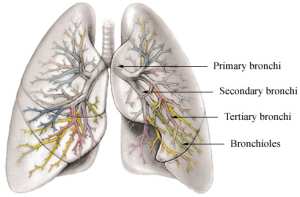

MedFriendly®


Bronchopulmonary
Bronchopulmonary means relating to the bronchi and
the lungs. The bronchi are types of small airways
connected to the lungs, which helps people breathe.
The term bronchopulmonary has several common uses
in the field if medicine. For example, there are
bronchopulomary segments, which are parts of the
tertiary bronchi that each have their own artery (blood
vessel that carries blood away from the heart). Tertiary
bronchi are bronchi that arise from the secondary
bronchi, which in turn, arise from the primary bronchi.
The best way to visualize this is that the bronchi branch
off of one another like a tree limb.
The lungs and the bronchi.
FEATURED BOOK: Muller's Diseases of the Lung
Another common use of the term bronchopulmonary is bronchopulmonary dysplasia.
Bronchopulmonary dysplasia is a chronic (long-lasting) lung disorder that is most common
in children who are born prematurely, underweight at birth, and who need prolonged
respiratory support through mechanical ventilation (artificial respiration) to treat
respiratory distress syndrome (a type of breathing disorder). There is bronchopulmonary
sequestration, which is a rare birth defect of the lower respiratory tract causing part of
the lung tissue to not function. Any disease of the bronchi and lungs can be referred to as
bronchopulmonary disease. Bronchopulmonary comes from the Greek word “bronchus”
meaning “windpipe,” and the Latin word “pulmo” meaning “lung.” Put the words together
and you get “windpipe lung.”
"Where Medical Information is Easy to Understand"™















